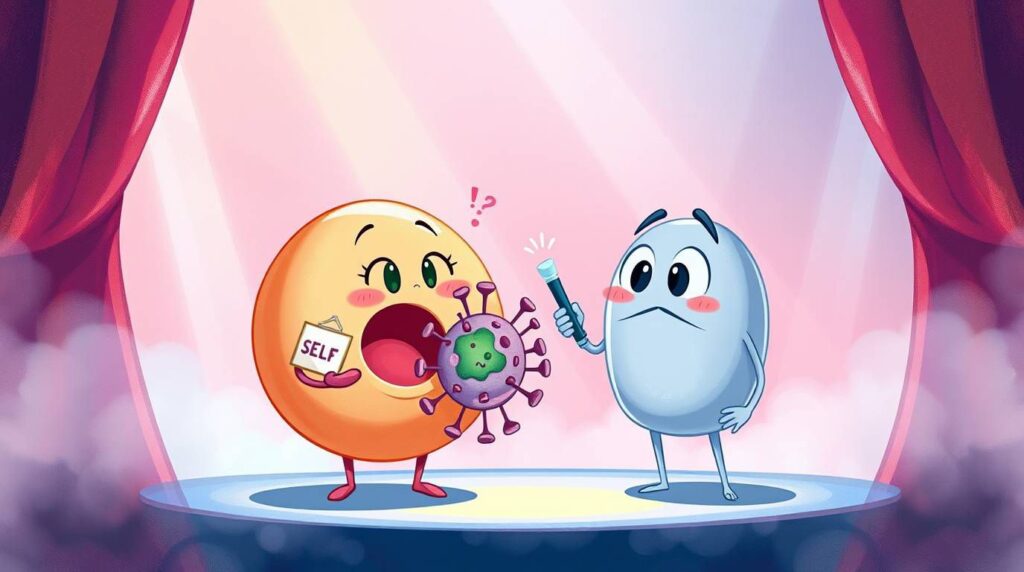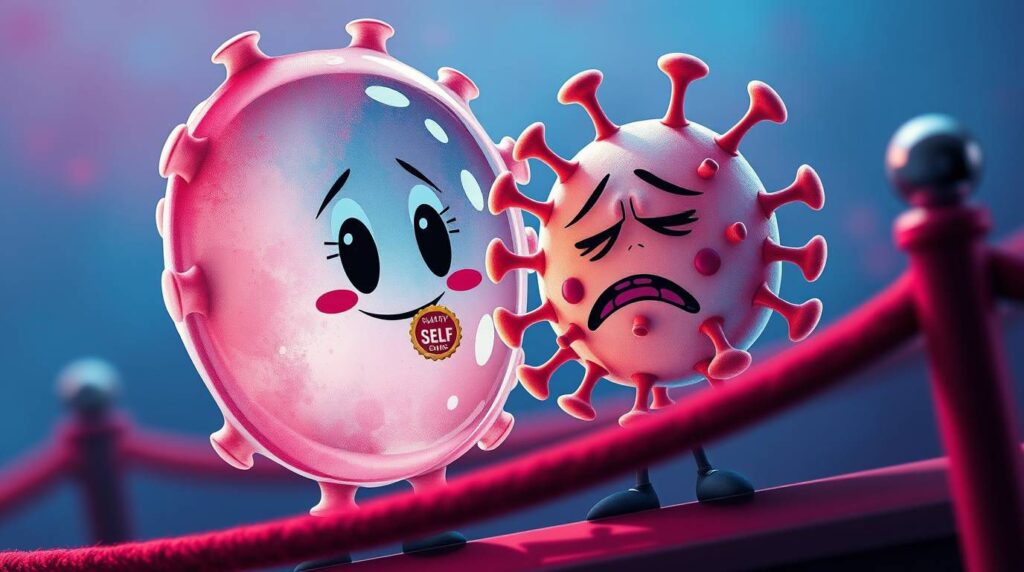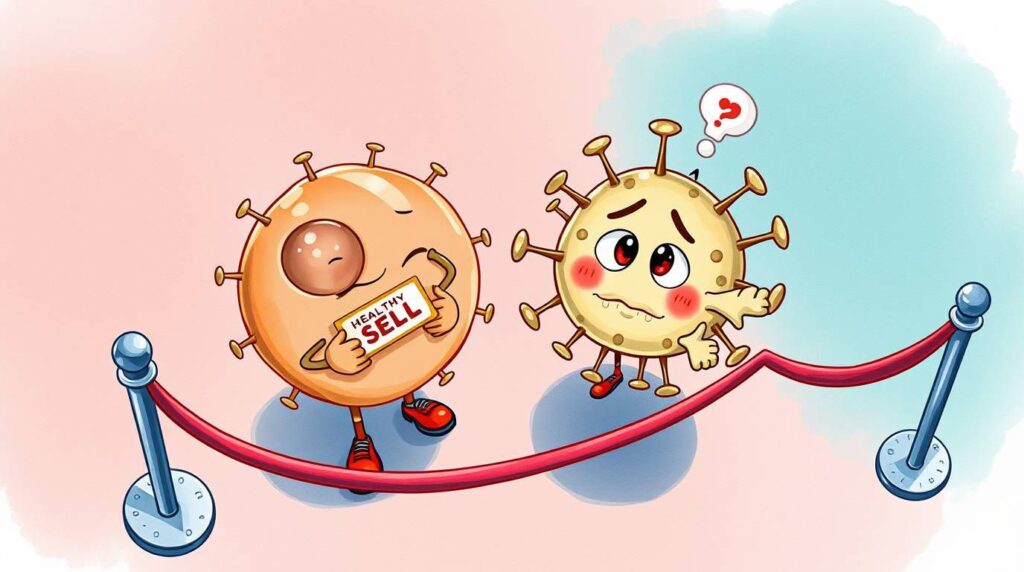How does the immune system distinguish self from non-self?
You’re here — which means you’re not just skimming for textbook definitions, you’re actually trying to understand how the immune system knows what’s you and what’s not you. 🧬🤺
So forget the robotic terms and boring diagrams for now. Let’s break this down in the easiest, friendliest way — like a teammate explaining the game strategy right before the match.
How Does the Immune System Distinguish Self from Non-Self?
Alright — imagine your body is a high-security concert venue. 🎤 Your immune system? It’s the security team. Their job is to check every person (cell, bacteria, virus, etc.) at the gate to make sure they belong there.
Now here’s the big question: How does this immune team know who’s a VIP (you), and who’s a gatecrasher (invaders like viruses, bacteria, etc.)?
Let’s walk through the system, bodyguard-style. 💪
🧾 Step 1: The Body Issues ID Cards (a.k.a. MHC Markers)
Every cell in your body has a little “ID badge” stuck on its surface. These ID cards are called MHC molecules — major histocompatibility complex. Think of them as tiny biological name tags that say, “Hey! I belong here. I’m part of the squad.” 🪪
Your immune system learns these MHC markers early on in life. Like a super sharp security guard who memorizes the entire team’s faces and IDs during training. 👀
🚨 Step 2: Anything Without the Right ID Gets Flagged
Now let’s say a virus sneaks into your body. It doesn’t have your MHC badge. Boom — the immune system goes on high alert. 🚨 White blood cells like T-cells and macrophages show up and say, “Whoa! You don’t look familiar.” Then they attack.
This whole process is called immune recognition — spotting what’s “self” (you) vs “non-self” (invaders).
🧠 Step 3: The Immune System Learns (and Forgets)
But here’s what’s really cool — the immune system isn’t just strict. It’s also super smart. 🧠 It goes through a training phase (especially in the thymus) where it literally tests immune cells.
⚖️ If a cell reacts too strongly to your own body parts (self), it gets eliminated. This process is called “negative selection.” It’s like firing security guards who think your friends are criminals. ❌
The ones that stick around are the ones that can tell the difference — they don’t freak out when they see your cells, but they’re ready to pounce on anything unfamiliar.
—
💥 Step 4: Antigen Detection (Detective Mode)
Now for the detective work: when something foreign shows up (like a splinter with bacteria or a virus in your nose), it brings strange proteins called antigens.
Your immune system recognizes these as non-self because they’re nothing like your own body’s proteins.
Some immune cells — like B-cells — even make custom antibodies to match those foreign antigens. It’s like designing a lock that fits only one weird key. 🔐🦠
—



😱 But What If the System Messes Up?
Sometimes, the immune system gets confused — and starts thinking parts of your own body are “non-self.” That’s when autoimmune diseases happen. It’s like security guards suddenly arresting the band members of the concert. Not cool. 😖
Examples? Type 1 diabetes, lupus, rheumatoid arthritis — all cases where the immune system can’t tell friend from foe.
That’s why this whole “self vs non-self” recognition is not just cool — it’s crucial for your survival.
—
🔁 Recap – In the Friendliest Way Possible:
- Your cells wear “I’m part of the team” ID badges (MHC markers).
- The immune system memorizes these early in life.
- Anything without the right ID = invader = attack mode. ⚔️
- The immune system trains itself to not attack your own cells.
- When it sees something unfamiliar (non-self), it goes full defense mode.
- Mistakes in this system? That’s where diseases like autoimmunity come in.
—
So yeah — your immune system is like a full-on FBI, security squad, and detective agency all rolled into one. And the “self vs non-self” check is what keeps it from turning into pure chaos. 🧬🔐🕵️
—
📌 Disclaimer:
This easy version is meant to help you understand the concept better. If your exam or teacher expects a textbook explanation and you write this one instead, we’re not responsible if it affects your marks. Use this for understanding, not copy-pasting.
—
🔗 Related Articles from EdgyThoughts.com:
Why Do Some Genes Remain Inactive for Life?
https://edgythoughts.com/why-do-some-genes-remain-inactive-for-life
How Does Epigenetics Influence Gene Expression?
https://edgythoughts.com/how-does-epigenetics-influence-gene-expression
🌐 External Resource:
Want the textbook science version?
See: Self/Non-Self Recognition – Wikipedia
https://en.wikipedia.org/wiki/Self_(biology)
How Nanotech Is Revolutionizing Modern Medicine 2025
https://edgythoughts.com/how-nanotech-is-revolutionizing-modern-medicine-2025/
What are the benefits of studying abroad?
https://edgythoughts.com/what-are-the-benefits-of-studying-abroad/





